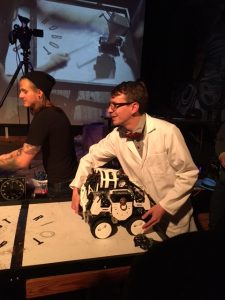
Robot Riot is the self-proclaimed backyard wrestling of robotics. Human-made robots attempt to destroy their opponents on table-tops for votes from the crowd or complete domination for the win. Our Design Engine team decided to visit Emporium’s Robot Riot: Homecoming Event on October 15, 2017 to see what all the fuss was all about. It was a fantastic event that allowed and encouraged anyone (even a six year old created his own bot) to create table-top sized robots to compete with one another. The event held several rounds where winners from each match played against each other. The idea was to destroy their opponents, but sometimes the battle would end in a stalemate. In this case, the robot (or its pilot) had to win the crowd in order to achieve victory. After, we spoke with a few of the competitors (Joshua, Kyle and Wade, and Carlos) and the organizers (Adrian and Joe) to get their take on the event.
 Joshua Clay (pictured on the left), whose background is in illustration and fine art (working with artists such as Gym Class Heroes, KoRn, Fall Out Boy, Trent Reznor/NIN and Linkin Park), competed with the ‘M1’ robot. Though he has been building robots for three years, this was his first battle. The ‘M1’ was a tank that was designed using Solidworks. He taught himself how to code c++, and python, and used Raspberry Pi for the brains of his robot. Also used for the creation of his bot were 3D printed parts he designed and printed.
Joshua Clay (pictured on the left), whose background is in illustration and fine art (working with artists such as Gym Class Heroes, KoRn, Fall Out Boy, Trent Reznor/NIN and Linkin Park), competed with the ‘M1’ robot. Though he has been building robots for three years, this was his first battle. The ‘M1’ was a tank that was designed using Solidworks. He taught himself how to code c++, and python, and used Raspberry Pi for the brains of his robot. Also used for the creation of his bot were 3D printed parts he designed and printed.
Joshua desired to learn Solidworks to acquire the ability to design and print his 3D parts. He explains, “I picked up the basic functionality pretty quick and it was so liberating being able to create designs and try out assemblies and tweak and micromanage little areas of the design without having to put all the time into doing that with trial and error or loads of time perfecting scroll saw cuts.”
According to Joshua the inspiration for his design came together by viewing images of robot chassis designs, suspensions, and event sci-fi concept designs. It was a balance of form meets function. His thoughts were, “Ok this works now, how do I make it look a little cooler without adding too much and without compromising the structural design.”


Kyle Granat (pictured above on the left), whose career focuses on designing 3D printers was the creator of two robots: ‘The Internet’ and, along with Wade, the ‘Butter Buster’ (pictured above on the right). ‘The Internet’ and The ‘Butter Buster’ were generated using CAD tools such as Fusion 360, a 3D printer and “Run my Robot” a software on Raspberry Pi.
A cool thing about ‘The Internet’ is that it has a camera, and its actually connected to the internet. The software is connected to letsrobot.tv and the platform lets anyone view/control the robot remotely. Similar to Twitch Plays Pokemon, the robot uses crowd sourcing to control the destiny of the battle.
Kyle attributes his robot-building skills to his mother for instilling the love of technology in him, and his experience of working at a robotics company. His job helped with having the resources and experience to build the robot.

The final contestant interviewed, and winner of the Robot Riot: Homecoming, was Carlos Garcia (pictured on the far right). Carlos’ career consists of developing software, and has done work on video games for 10 years. He says robot building is just a hobby at the moment. He constructed the ‘BarbieMobile’ and stuck to a simple but effective design, which allowed him to avoid the use of CAD/CAM or any other type of software.
When asked about making changes to the robot or what he would do differently next time he stated, “I was very impressed with some of the other robots for their creativity and craftsmanship. I will most likely add another motorized part. I don’t know if it will be functional, like ‘Hammer’ or ‘Flipper,’ or something just to entertain the crowd yet. I also need a better system of securing the BarbieMobile’s plastic car body to the chassis, if I use her again.”
After speaking with the contestants, we wanted to learn more about the organizers, Adrian Choy and Joe. Adrian states, “I founded Robot Riot in Chicago in 2015. I’ve always loved robot fighting but most of the existing leagues are out of reach unless you have tons of resources and decades of engineering experience. I wanted to make a robot fighting platform that was approachable for everyone and not as stuffy as existing competitions.” Adrian’s reasoning behind holding such an event allows others to “Look at it and think, ‘I can do this too’.” He also adds advice for future robot builders “Fail early, fail often, fail better. Failure is an excellent teacher. Don’t be afraid to start a project because of how it might turn out. You gain something through the process of creating even if the result falls short of your expectations.”
Last, we spoke with organizer Joe who told us he met Adrian at work about 5 months ago and has been interested in robots and battle bots for a long time. Joe adds, “I circuit bend (taking electronic devices and children’s toys and short circuiting them to make weird noises or unexpected uses) in my free time and sometimes build simple robots. My side of it is building the arena and generally being the hype man at the fights. When I finally get some free time I’ll be building some loaner robots for the fights, but Adrian is really the Robo-Daddy.” Joe would love to see the the future of this event “Evolve into a community of robot fighters across the country” while learning about technology in a fun way. A final piece of advice Joe give to others, “Sometimes you don’t even have to finish a project like a robot to learn what you need to from it. If I had to estimate, I have 10-20 half build machines that I just stopped building because I learned something from it and realized it would be easier to start over than continue the current project, and that’s not a bad thing! You’ll get really good at soldering and assembling that way really fast.”
Regardless what software program was used, the engineering expertise of the designer, or the mechanical aptitude of the person doing the soldering, there are many ways to design a robot. It may take a lot of trial and error, but all the errors will be the key to success – as long as you learn from your mistakes. As we like to say at Design Engine, if you don’t crash you aren’t trying hard enough. The key to victory in Robot Riot is not always through displays of robo-violence, but also winning the crowd and carrying yourself with a certain sense of style. For those interested in joining the fight, shoot Adrian and Joe a message on their Facebook Page @robotriotcompetition.
Written by Laila Ramadan and Eli Petrov for Design Engine, October 24th, 2017


